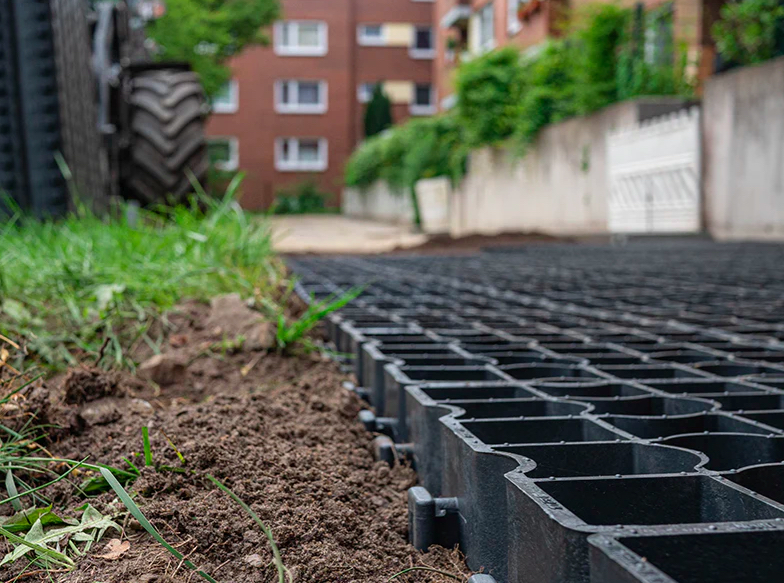Porous paving is a method of giving structure to the ground for the purposes of providing vehicle access. In laypersons terms, it is an alternative to tarmac or asphalt-based road surface materials. Porous paving is a method of providing a structural base for a road or path, but leaving space between the structural elements, allowing plants to continue growing across the road surface. The structural base prevents the ground from rutting out or becoming impassible, just as industrial road surfaces would do. However, the environmental impact of porous paving is much lower than traditional road materials such as tarmac or asphalt.
I am choosing my words carefully here, because as a bi-lingual American living in England, this is a linguistic minefield. Americans say “paving”, as in “let’s go pave the driveway.” When they talk about paving, they mean laying asphalt. If I say, “let’s go pave the driveway” to builders in England, they think I mean lay paving slabs – like the kind you walk on, not the kind you drive on. I was recently in charge of a road resurfacing project in Hertfordshire, and all sort of linguistic high jinks ensued as I regularly confused the builders with my Americanisms. But I digress.
Primarily for the purposes of avoiding confusion, let me clarify that I am investigating the use of porous paving to provide vehicle access between a rural house and its outbuildings. [This is in the context of our renovation project in North Yorkshire, Holmefield.] We are preparing to renovate the bungalow that is nestled in a lovely rural setting with derelict outbuildings that were previously used as barns. Recently, we had to substantially repair the barns after a winter storm decimated one of the buildings. In doing so, quite a bit of the ground was churned up by construction equipment traversing the fields. The field between the main house and barns can get boggy when it is wet (which it often is in North Yorkshire).
To prevent additional damage, we agreed that we need some sort of hard standing over part of the field to provide a route for vehicles to access the barns. Gravel is, of course, an option, but it requires regular replenishment and regular removal of little stones from ones shoes and vehicles. Enter porous paving as a building material for consideration, especially in more rural settings. Porous paving provides an alternative to tarmac, asphalt, or gravel that enables grass to continue growing in the pores of the material. EcoGrid, for example, provides porous paving made from fully recycled plastic, and is, itself, easily recycled when it comes to the end of its useful life.
If we were to lay asphalt instead of porous paving, it would have an estimated embodied carbon footprint of at least one ton. Porous paving works by providing a low profile structure that can be filled with either gravel or dirt, providing a wide range of choice as to the final aesthetic of the surface. It is a worthwhile consideration for those who prefer not to lay tarmac or asphalt, or for anyone needing a temporary road surface. It provides a sturdy foundation with a limited impact on the environment.

*Assumed 25mm asphalt binder and bitumen over 200 meters plus the reduction of carbon capture by the removal of grass and other plants from the space.